Makeup sponges have become a game-changer in achieving flawless, airbrushed finishes. They offer a versatile alternative to traditional brushes, allowing for seamless blending and precise application. But with a wide array of options flooding the market, knowing which sponge best suits your needs can be overwhelming.
Statista’s 2022 survey has projected that the makeup sponge market worldwide will be $1.65 billion by 2026. The Compound Annual Growth Rate (CAGR) from 2021 to 2026 is 7.5%. The increasing use of makeup sponges can be attributed to the growing popularity of makeup application methods such as contouring and baking.
This blog post will examine different makeup sponges and highlight their distinctive features, advantages, and recommended applications. Whether you’re new to makeup or an experienced professional, this all-inclusive guide will assist you in making an informed choice when choosing your next makeup sponge.
Different Types of Makeup Sponges
1. Traditional Makeup Sponges
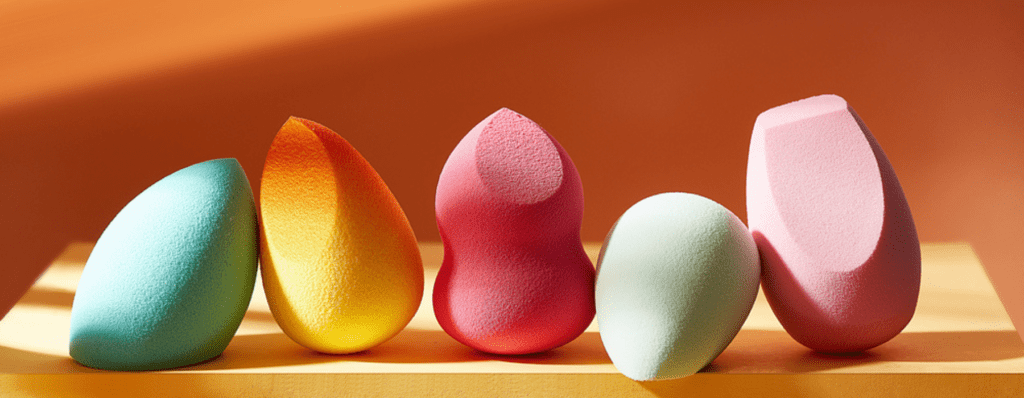
As a wholesale buyer in the beauty industry, it is crucial to understand the products you offer to your customers. Makeup enthusiasts and professionals alike widely use traditional makeup sponges. These versatile tools come in various shapes, sizes, and materials, each offering unique benefits.
Materials
Natural Sea Sponges
For centuries, people have utilized natural sea sponges to apply makeup. They are harvested from the ocean, making them a sustainable and eco-friendly choice. These sponges have a porous structure, which allows them to absorb and distribute liquid or cream products evenly on the skin. Natural sea sponges are soft and gentle, ideal for sensitive skin types. In addition, they provide a natural, airbrushed finish and are known for their durability.
Synthetic Sponges
Sponges that are not natural are called synthetic sponges, and they are created using materials like polyurethane, latex, or non-latex foam. These sponges are highly popular due to their affordability and accessibility. Synthetic sponges are available in various shapes, including wedge-shaped, teardrop-shaped, and round. They are often used for applying foundation, concealer, and other liquid or cream-based products. In addition, synthetic sponges are generally hypoallergenic and latex-free, making them suitable for individuals with latex allergies.
Latex Sponges
Latex sponges are made from natural rubber latex and are widely used in the beauty industry. They offer excellent elasticity and durability, allowing for precise application and blending of makeup. In addition, latex sponges are known for their ability to create a flawless, airbrushed finish. However, please remember that some individuals have a latex allergy. Therefore, providing latex-free alternatives for customers with latex sensitivities is crucial.
Cellulose Sponges
Cellulose sponges are composed of plant-based materials and are highly absorbent. They are often used for removing makeup or applying skincare products. Cellulose sponges have a soft texture and provide gentle exfoliation, making them suitable for sensitive skin. In addition, these sponges are biodegradable and environmentally friendly, making them an excellent choice for customers seeking sustainable options.
Microfiber Sponges
Microfiber sponges are made from ultra-fine synthetic fibers that are densely packed together. As a result, they are incredibly soft and offer excellent absorbency. Microfiber sponges are particularly effective for applying powder-based products, such as blush or setting powder, providing a seamless and natural finish. In addition, makeup artists and enthusiasts favor these products because they are simple to clean and maintain.
2. Beauty Blender
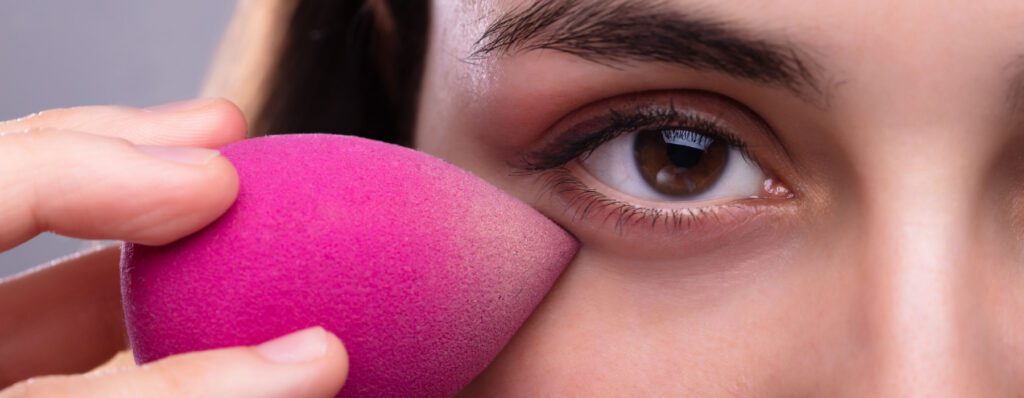
To achieve a perfect makeup look, both makeup enthusiasts and professionals rely on the essential tool known as the beauty blender sponge. This innovative beauty tool has revolutionized how makeup is applied, providing seamless coverage and a natural-looking finish. If you are a wholesale buyer looking to stock up on high-quality beauty sponges, read on to discover more about Beauty Blender sponges and their materials.
The Beauty Blender Sponge is a versatile and unique makeup applicator created by Rea Ann Silva, a renowned Hollywood makeup artist. This product became popular because it can provide airbrush-like results with little effort. In addition, the sponge is designed to be used wet, which allows for a flawless and streak-free application of various makeup products, including foundation, concealer, blush, and even powder.
Material
One critical factor that sets Beauty Blender sponges apart from other makeup sponges on the market is the material used in their construction. The sponges are made from a proprietary foam material that is latex-free, hypoallergenic, and odor-free. This ensures they are safe and suitable for all skin types, including sensitive ones.
The unique foam material used in Beauty Blender sponges is designed to be super soft and bouncy. This allows the sponge to blend makeup into the skin effortlessly, resulting in a flawless and natural-looking finish. The sponge’s elliptical shape and rounded edges further aid in the seamless application of makeup, ensuring no harsh lines or streaks are left behind.
3. Silicone Makeup Sponges
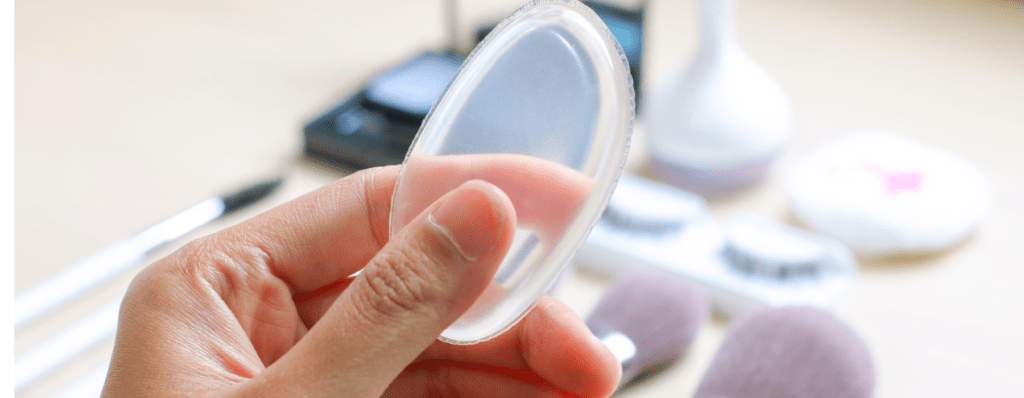
Silicone makeup sponges are innovative tools for applying and blending makeup products onto the skin. Unlike traditional makeup sponges, often made from latex or foam, silicone sponges are made from medical-grade silicone materials. They are typically transparent or translucent and come in various shapes and sizes.
Materials Used in Silicone Makeup Sponges
- Medical-grade Silicone: Silicone makeup sponges are primarily made from medical-grade silicone, a high-quality, non-toxic material. This type of silicone is hypoallergenic and safe to use on the skin. It is free from harmful chemicals and does not cause any irritation or allergic reactions. This product is appropriate for all skin types, even those with sensitivity.
- Non-porous Surface: Silicone sponges have a non-porous surface, which means they do not absorb and waste any product. Unlike traditional makeup sponges that soak up a significant amount of foundation or other products, silicone sponges ensure that every drop is used efficiently, reducing product wastage.
- Easy to Clean: Another advantage of silicone makeup sponges is their ease of cleaning. Due to their non-porous surface, they do not retain any makeup residue, making them hygienic and easy to maintain. Rinse the sponge with warm water and mild soap; it will be ready to use again. This feature is especially beneficial for professional makeup artists who require frequent cleaning between clients.
- Durability: Silicone makeup sponges are known for their durability. These products are built to endure frequent use and retain their form and functionality throughout their lifespan. Unlike foam or latex sponges that can tear or disintegrate with repeated use, silicone sponges are long-lasting and offer great value for money.
- Versatile Application: Silicone makeup sponges can be used for various makeup products, including foundation, concealer, blush, and even skincare products. Wholesale buyers can offer a versatile tool that meets the needs of multiple customers, ensuring customer satisfaction and loyalty.
4. Natural Fiber Makeup Sponges
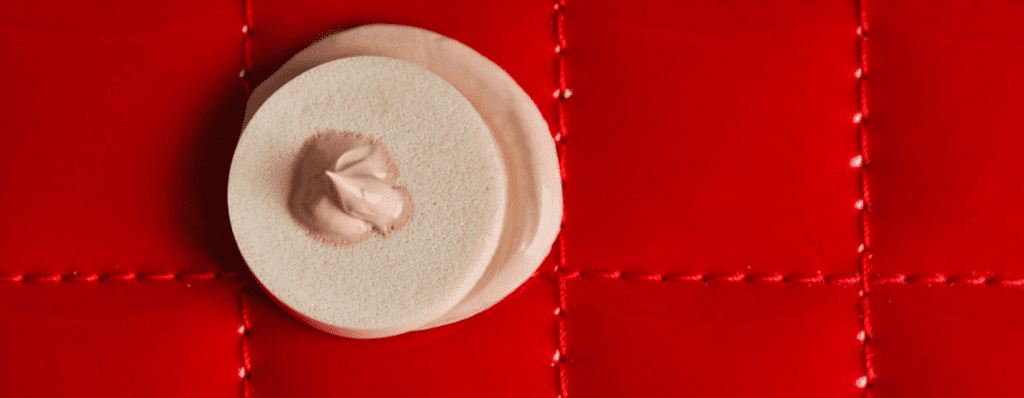
Natural fiber makeup sponges have gained popularity among beauty enthusiasts due to their eco-friendly and skin-friendly properties. These sponges are made from various raw materials, each offering unique benefits for makeup application. Therefore, understanding the different natural fiber options available for wholesale buyers looking to provide sustainable and high-quality beauty products is crucial.
Materials
- Konjac Sponge: Konjac Sponges are crafted from the root of the konjac plant, a perennial plant indigenous to Asia. These sponges are known for their gentle exfoliating and cleansing properties, making them ideal for sensitive skin. In addition, Konjac sponges are naturally alkaline and help balance the skin’s pH levels while effectively removing makeup and impurities.
- Sea Sponge: Sea sponges are harvested from the ocean and used for centuries in beauty rituals. These sponges are incredibly soft and absorbent, perfect for applying liquid or cream-based makeup products. Sea sponges are also hypoallergenic and resistant to bacteria, offering a hygienic option for makeup application.
- Bamboo Charcoal Sponge: Bamboo charcoal sponges are infused with activated bamboo charcoal, known for its detoxifying properties. These sponges absorb excess oil, dirt, and toxins from the skin, making them suitable for oily or acne-prone skin types. Bamboo charcoal sponges also provide gentle exfoliation, promoting a smoother and clearer complexion.
- Hemp Sponge: Hemp sponges are made from natural hemp fibers known for their durability and sustainability. These sponges are gentle on the skin and offer excellent moisture retention, allowing for seamless makeup application. Hemp sponges are also naturally antimicrobial, making them a hygienic choice for daily use.
- Cellulose Sponge: Cellulose sponges are derived from plant-based materials, such as cotton or wood pulp. They are highly absorbent and provide a smooth and even makeup application. In addition, cellulose sponges are biodegradable and eco-friendly, making them an ideal choice for buyers seeking sustainable beauty products.
5. Latex-Free Makeup Sponges
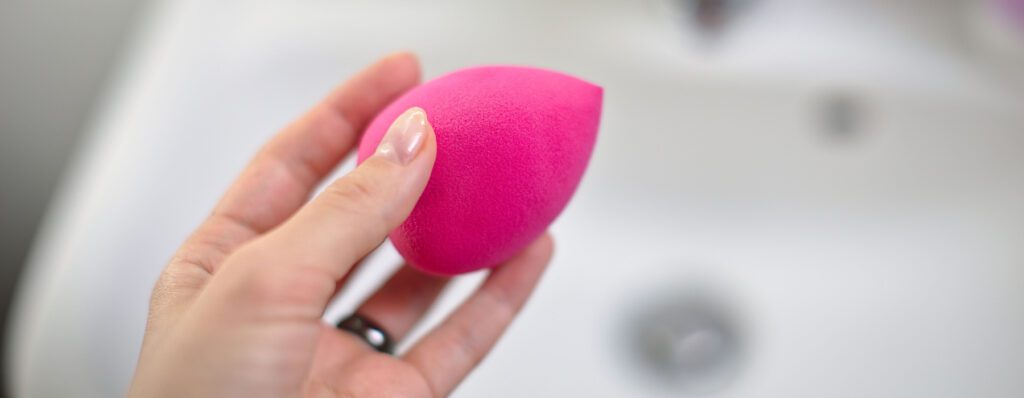
Latex-free makeup sponges are cosmetic tools for applying and blending makeup products, including foundation, concealer, powder, and cream-based formulas. They are designed to provide a seamless and flawless finish while being gentle on the skin. Unlike traditional makeup sponges that contain latex, which can cause allergic reactions in some individuals, latex-free sponges are made from alternative materials that offer similar functionality without the risk of allergies.
Materials Used in Latex-Free Makeup Sponges
- Hydrophilic Polyurethane Foam: Hydrophilic polyurethane foam is a commonly used material in latex-free makeup sponges. This material is known for its softness, durability, and ability to absorb and distribute liquid products evenly on the skin. In addition, the porous nature of polyurethane foam allows for easy blending and a natural-looking finish.
- Non-Latex Synthetic Materials: Various non-latex synthetic materials, such as microfiber and silicone, are also used to create latex-free makeup sponges. Microfiber sponges are made from ultra-fine fibers that provide a smooth application and help create an airbrushed effect. Unlike other sponges, silicone sponges are non-porous and won’t absorb any product.
Advantages of Latex-Free Makeup Sponges for Wholesale Buyers:
Allergy-Friendly
The primary advantage of latex-free makeup sponges is that they cater to individuals with latex allergies. In addition, by offering latex-free options, wholesale buyers can ensure their products are accessible and safe for a broader customer base, thus expanding their market reach.
Versatility
Latex-free makeup sponges are highly versatile tools suitable for various makeup techniques. They can achieve different levels of coverage, from sheer to complete, and are compatible with both liquid and powder formulations. As a result, wholesale buyers can offer a versatile range of makeup sponges to cater to their customer’s diverse needs and preferences.
6. Wedge Sponge
Wholesale buyers are crucial in various industries’ distribution and supply chains. To effectively cater to the needs of their customers, they must stay up to date with the latest products and tools available in the market. One such essential tool that wholesale buyers should be familiar with is the Wedge Sponge.
Wholesale buyers are crucial in various industries’ distribution and supply chains. To effectively cater to the needs of their customers, they must stay up to date with the latest products and tools available in the market. One such essential tool that wholesale buyers should be familiar with is the Wedge Sponge.
Materials Used in Wedge Sponge Construction
Wedge Sponges are typically made from a combination of materials carefully chosen for their specific properties and functionality. The primary materials for constructing Wedge Sponges include foam and natural or synthetic fibers. We will examine each of these materials in more detail.
- Foam: Foam is a lightweight and porous material commonly used in producing Wedge Sponges. It offers excellent absorption capabilities, making it ideal for cleaning or applying liquid substances. The foam used in Wedge Sponges is usually made from polyurethane, which provides durability and resilience.
- Natural or Synthetic Fibers: The outer layer of a Wedge Sponge is typically made of natural or synthetic fibers, depending on the intended use. Natural fibers like cotton are soft and gentle, making them suitable for sensitive applications like makeup removal or skincare routines. On the other hand, synthetic fibers, such as nylon or polyester, are known for their durability and ability to withstand rigorous use. As a result, they are often preferred for tasks that require more aggressive scrubbing or cleaning.
7. Stippling Sponge
A stippling sponge, also known as a texture sponge or a dotting sponge, is a specialized cosmetic tool that offers exceptional control and precision during makeup application. It is typically made of high-quality materials and has a distinctive texture of tiny, evenly-spaced dots or pores. The design of a stippling sponge allows it to hold and distribute products evenly onto the skin, ensuring a flawless finish.
Materials Used in Stippling Sponges
- Latex: Latex stippling sponges are famous for their durability, flexibility, and affordability. They are made from natural latex rubber, which provides a soft and bouncy texture. Latex sponges are ideal for liquid and cream products, allowing seamless blending and buildable coverage.
- Non-Latex Foam: Non-latex foam stippling sponges are an excellent alternative for individuals with latex allergies or sensitivities. These sponges are typically made from polyurethane foam or polymeric materials. Non-latex foam sponges offer similar benefits to latex sponges and are often hypoallergenic.
- Silicone: Silicone stippling sponges have gained popularity due to their unique properties. These sponges are made from medical-grade silicone, making them resistant to bacteria and easy to clean. In addition, they are non-porous and do not absorb product, resulting in less product waste. Silicone sponges are particularly effective for applying foundation and other liquid or cream-based products.
- Hybrid Sponges: Some stippling sponges combine different materials to maximize performance. For example, a hybrid sponge might have a latex or non-latex foam core encased in a silicone outer layer. These hybrid sponges offer the benefits of both materials, such as flexibility, durability, and non-porous properties.
8. Konjac Sponge
Konjac sponges originate from the Konjac plant, also known as Amorphophallus konjac, which is native to Asia. These sponges have gained significant popularity recently due to their eco-friendly nature and effective skincare benefits. Konjac sponges are prized for their soft, jelly-like texture and ability to cleanse and exfoliate the skin without irritating it.
Materials Used in Konjac Sponges
- Konjac Root Powder: The primary material used in Konjac sponges is derived from the Konjac plant’s root. The root is processed into a fine powder, then mixed with water to form a gel-like substance. This natural material is rich in vitamins (such as A, E, and D) and minerals (including zinc, copper, and magnesium), making it beneficial for the skin.
- Water: Konjac sponges require water to activate and expand. The water used during manufacturing should be high quality and free from contaminants to ensure the sponge’s purity. Manufacturers often emphasize using filtered or purified water to maintain the integrity of the product.
- Natural Additives: While the core material of a Konjac sponge is derived from the Konjac plant, manufacturers sometimes incorporate additional natural ingredients to enhance the sponge’s properties. These additives include activated charcoal, green tea extract, bamboo charcoal, aloe vera, or lavender. These ingredients are carefully chosen for their specific benefits, such as detoxification, anti-inflammatory properties, or soothing effects.
Costs Depending on Materials
Regarding sourcing makeup sponges for wholesale purposes, China has become a popular destination for many businesses due to its competitive pricing and vast manufacturing capabilities. However, it’s essential to understand that the cost of makeup sponges can vary significantly depending on the materials used.
Natural Latex Sponges: Natural latex sponges are known for their softness and durability. They are sourced from rubber tree sap and offer excellent absorption and blending properties. However, due to their high quality, natural latex sponges are more expensive than synthetic alternatives. The wholesale cost of natural latex makeup sponges from China can range from $0.80 to $1.50 per unit, depending on size, shape, and packaging factors.
Synthetic Foam Sponges: Synthetic foam sponges, often made from polyurethane, are popular in the cosmetics industry. This is because they are cost-effective, readily available, and provide a smooth application. In addition, these sponges come in various shapes, sizes, and densities, allowing for versatility in makeup application. The wholesale cost of synthetic foam makeup sponges from China typically ranges from $0.20 to $0.60 per unit, depending on the specifications and quantity ordered.
Silicone Sponges: Due to their unique characteristics, silicone makeup sponges have gained popularity in recent years. These sponges are non-porous, easy to clean, and do not absorb product, resulting in minimal product wastage. They are also long-lasting and offer a smooth, streak-free application. However, silicone sponges’ manufacturing process and material costs tend to be higher. The wholesale price of silicone makeup sponges from China can range from $0.80 to $2.00 per unit, depending on the design and features.
Konjac Sponges: Konjac sponges, made from the konjac plant’s root, are natural and biodegradable options gaining popularity in the beauty industry. These sponges are gentle on the skin, exfoliating and cleansing without irritating. The wholesale cost of konjac makeup sponges from China typically ranges from $0.40 to $0.80 per unit, depending on size, shape, and additional ingredients.
Benefits of importing from China Makeup Sponge wholesale market
China is often one of the first countries that come to mind when importing wholesale items. Here are some advantages of importing wholesale cosmetics from China:
- Affordable Prices: Chinese markets are known for their competitive prices. Compared to other countries worldwide, Chinese products are significantly more cost-effective.
- Reliable Quality: Despite their lower prices, Chinese market products maintain a high standard of quality compared to products from other countries in the same price range. Chinese manufacturers prioritize the quality of their goods, ensuring that you receive high-quality products at a lower cost. This allows you to attract more customers and increase your income.
- Exclusive Offerings: China offers a wide range of unique and rare products that may be challenging to find elsewhere. The Chinese market is your go-to destination if you want to purchase distinctive wholesale goods. By incorporating unique items like these, you can effectively differentiate yourself from competitors and draw in a more extensive customer base.
Conclusion: Enhancing Your Makeup Routine with the Perfect Sponge
In conclusion, exploring the different types of makeup sponges has revealed the versatility and effectiveness of these beauty tools. Each type offers unique benefits, from latex to silicone to beauty blenders, and caters to different makeup application techniques.
Panda Sponge stands out as the leading manufacturer and supplier for wholesale buyers when purchasing makeup sponges in bulk. Their dedication to delivering high-quality products, fostering innovation, and ensuring customer satisfaction has earned them a reputable and trustworthy position in the industry. With a wide range of options and exceptional customer service, Panda Sponge provides that professional wholesale buyers can access top-notch products.
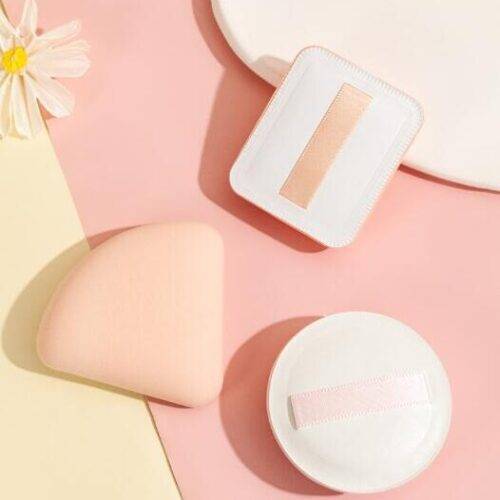
Get a Quote
Custom Makeup Sponge and Puffs

Maggie Peng serves as the esteemed Product Manager at Panda Sponge, where she has garnered a wealth of experience and expertise over the course of five years. With a primary focus on product design, testing, and development, Maggie has consistently exhibited her prowess in these domains.

